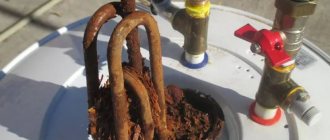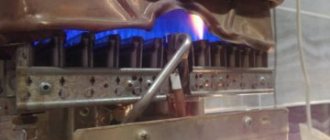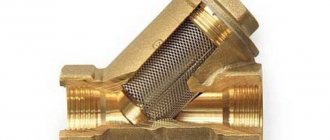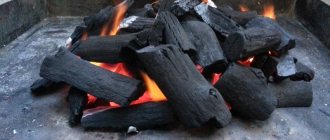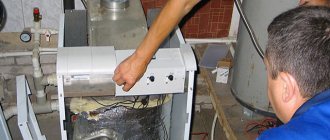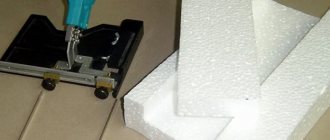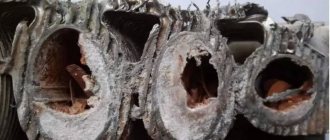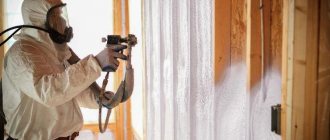Previously, when the heating system was a stove, there were no problems getting rid of soot. And such a profession as a chimney sweep was held in high esteem. Now many people use boilers as a heating system. But in order to ensure uninterrupted operation, you need to observe simple conditions and clean them on time, as well as carry out preventive inspection of the equipment.
Causes and consequences of clogging
To answer this question, you need to know which boiler is in the house: energy-dependent or mechanical.
Energy-dependent ones are in turn divided into:
- gas processing;
- electrical installations;
- solid fuel and liquid fuel equipment;
- combined models.
Volatile boilers may turn off for a number of reasons:
- voltage drops and surges in power lines
- lack of electricity
- factory settings failure.
Often used in homes: AOGV, Zhukovsky boiler, gas “Ochag”, Lemax, Signal, Conord .
How to clean a chimney pipe in a private house: a detailed analysis of cleaning methods, tips, prices. Do-it-yourself furnace: drawing, operation diagram. Read here.
Connection to the city water supply network: documents, prices:
https://klimatlab.com/vodosnabzhenie/vodoprovod/podklyuchenie-k-gorodskoj-seti-v-chastnom-dome.html
Mechanical ones may work intermittently due to wind flow entering the chimney. In addition, due to insufficient oxygen, the flame may go out. You should pay attention to the hood (cheaper models do not always have it).
If the chimney becomes dirty, modern devices have a warning system that will notify you of problems and the need for cleaning.
How to clean a boiler using a chemical method?
Boilers are cleaned either chemically or mechanically.
These methods are extremely rarely combined. For the cleaning process to be successful, you will need:
- scrapers;
- brushes;
- scrapers
- screwdriver;
- fabric gloves;
- corresponding electrical devices (spreading and non-spreading heads).
Before any type of cleaning, the boiler must be turned off and the power source must be disconnected. After this, you need to turn off the gas tap and heating shut-off valves, then wait for the boiler to cool completely. When choosing a tool, pay attention to the absence of sharp edges and ends, which can damage the internal parts of the unit and subsequently cause corrosion.
Functional diagrams of boilers.
Chemical cleaning of boilers is very common precisely because of the ease of the process. To do this, the reagent is heated to the required temperature, then, using a special pump, it enters the boiler system and enters into a chemical reaction with deposits and scale.
Acids for cleaning:
Adipic acid is diluted with water and very carefully poured into the cooled boiler using a pump. Carbon dioxide affects carbonates, which are converted into acid salts and subsequently dissolved. After this, it is necessary to release the pressure and wait until the acidic salts precipitate, which is easily washed off with plain water. Sulfamic acid must be diluted with water in a separate vessel, and then pumped under pressure into a cooled gas boiler. After some time, the boiler is washed with high pressure of water and dried. The gel is not an acid, but it is capable of dissolving any petroleum derivatives, as well as effectively separating scale from metal parts. The gel allows you to clean the gas boiler gently and carefully without damaging its walls.
The disadvantage of chemical boiler cleaning is that the acid cannot be controlled. During exposure, along with scale, the acid reacts not only with deposits, but also with metal parts of the boiler that are not covered with dirt. This effect can be reduced by adding inhibitors to the cleaning composition.
Cleaning methods
Cleaning is carried out in two ways: mechanical and chemical
Mechanical cleaning
The cleaning method is imperfect and involves mechanical action. Soot should be carefully removed so as not to damage the internal surface of the boiler and parts, which can subsequently lead to metal corrosion. Often the tools come with the boiler - these are pipe cleaners, brushes and scrapers. It is also possible to use air cleaning, when warm air is supplied under pressure.
Dry cleaning
It is recommended to apply cleaning agents while wearing PPE (personal protective equipment); rubber-based gloves are usually used, this will protect the skin from interaction with harmful substances. Chemicals clean not only soot, but also metal, which can further lead to its destruction. This method is best used on minor dirt and small areas of contamination.
Hydrodynamic cleaning
Hydrodynamic cleaning or how to clean soot from a diesel boiler.
It is used in boilers with a small thickness of contamination, as well as when speed of execution is required. Equipment for such washing consists of:
- pump and
- containers with water supplied under high pressure.
Thanks to this cleaning, soot and soot are removed quite quickly, but this method can only be used by specialists and is not recommended at home.
Booster cleaning
The procedure for flushing the heat exchanger with a booster (using the example of cleaning a Zhukovsky boiler from soot):
- First you need to disconnect the pipes from the heating system.
- Next, connect a booster hose to one of them to supply the reagent.
- We connect the second pipe to the second end of the hose. The spent reagent will be removed through it. This closes the system and the reagent will circulate through the pipes.
- After cleaning, the solution must be drained from the tube.
- Rinse the heat exchanger itself with sufficient water.
Booster is a device for chemical cleaning. Thanks to it, the reagents circulate autonomously.
During such cleaning, it is recommended to change the reagent several times, since the old one gradually reduces its properties. This method is most often carried out by specialists.
Contact a professional or do it yourself
Professional cleaning of heating boilers is an expensive proposition. Depending on the condition of the equipment and the specifics of its operation, amounts can range from several tens to hundreds of dollars. In addition, the masters rarely arrive within the next few hours; sometimes you have to wait for them for several days. It is not comfortable.
The cost of professional cleaning using a special station for washing heat exchangers pays off: the parts are washed from the inside to a shine, and the equipment works much better. But if you want, you can always save money and do the same thing yourself. The result will be no worse, and you will only have to invest your own time and effort.
Professional device for washing heat exchangers
Time to clean the heat exchanger
When it is necessary to flush the heat exchanger of a gas boiler is a common question. There are a number of signs by which you can be sure that the time has come.
Some of the main ones:
- constantly switched on gas burner;
- the circulation pump has become noisier, which means it is overloaded;
- heating radiators began to heat up longer;
- gas consumption increases;
- The water pressure has become weaker (the first sign for flushing a double-circuit boiler).
In addition to cleaning the chimney, the boiler is also cleaned of soot. If the operation of the chimney is difficult, then in some cases it turns off, but if it becomes clogged with soot, this does not happen. Combustion products are released into the air, and the owners breathe them.
It is recommended to clean boilers once a year , especially if there is year-round operation.
About the dangers of scale
Scale that forms in key components of a gas boiler leads to the following negative consequences:
- The thermal conductivity of the part deteriorates, since scale has high porosity.
- Scale deposits lead to uneven heating of the system, which can lead to ruptures at the welding points of various elements of the device.
- The information supplied to the liquid temperature control sensors no longer corresponds to reality. This will reduce the performance of the equipment.
- Partial or complete blockage of the working ducts will, in the long term, lead to breakdown of expensive equipment.
See also
How often to put salt in the dishwasher, how much and what kind of salt you can, what is it for?
Disassembling and removing soot from the inner surface of the boiler
In order to clean the entire system at home, you will need the following tools:
- screwdriver;
- metal brushes (soft and for metal);
- brush;
- open-end wrenches;
- rags or any cotton fabric.
Stages of work:
- Turn off the gas.
- Remove the boiler door and disconnect the wire leading to the piezoelectric element.
- Unscrew the thermocouple, ignition electrode and pilot burner tube one after another.
- Replace with a new gasket under the pilot burner.
- Remove the nozzle, copper tube, burner.
- Carefully remove the thermometer sleeve, and then remove the boiler lid along with the insulating sheet.
- Disconnect the terminals from the traction sensor and remove the gas duct.
Before cleaning, turn off the gas supply, wait for the structures to cool completely and only then disassemble.
After removing all the parts, you need to:
- clean with a brush and metal brushes.
- The channels should be blown out with a vacuum cleaner.
- Particular attention should be paid to the burner, since the internal channel can be easily damaged; it must be wiped carefully.
Wood boilers are often used for heating in homes. And only a few people think about what kind of firewood they should choose for kindling. Usually they use everything they have. Firewood containing resin causes particular harm to chimneys. It settles on the walls of the boiler and the chimney pipe. Mechanical cleaning is required. In this case, the chimney must be cleaned from the roof to remove any remaining tar and soot, so that combustion residues will be easier to remove from the inside. Observe safety precautions!
Types of pollution
The types of waste are formed depending on what exactly is thrown into the boiler for combustion to release heat. The consequences of combustion are the formation of ash and ash, and other products, on the walls of the unit. If you do not clear the surface of them in time, the efficiency of the boiler becomes significantly lower.
The main cause of soot is the lack of oxygen during the combustion process. If you use low-quality fuel, put wet products into the boiler or, in order to save money, set the boiler to constantly operate in low mode, be prepared to deal with soot. An overcrowded firebox also causes malfunctions.
Tar is formed if there is low air flow in the combustion chamber and the unit is not configured correctly. A low chimney also provokes the accumulation of tar.
Consequences of not cleaning
If there are a lot of harmful substances in the boiler and the user does not take any action to eliminate them, the following negative processes occur:
- the boiler begins to heat worse;
- the house becomes noticeably cool, even when setting the usual operating mode indicators;
- there is a need to use more fuel;
- The service life of the boiler is rapidly decreasing.
The benefit of regular cleaning is to extend the life of the unit and ensure its proper operation.
How often should I clean?
To determine the frequency of cleaning, it is important to consider the quality of the fuel material used. Frequency figures are approximate
The main criterion is the operation of the boiler. Doesn't function as well as before? It is advisable to read out of turn
Frequency figures are approximate. The main criterion is the operation of the boiler. Doesn't function as well as before? It is advisable to perform the reading out of turn.
